Transitioning
Transitioning is the alteration of one’s Gender Presentation (or Gender Expression), either through social or medical means. The choice to transition is personal, and the ways in which transition is expressed varies from person to person. Some people will only change their name and pronouns. Others will take hormones and get gender-affirming surgeries. There is no one true way to transition, and there is no rule saying that one has to transition in order to be Trans. The rule to transition is just that you do whatever makes you most comfortable in yourself. Here are some examples of how one does that.
Coming Out
Coming out is a rather intense decision for a trans person. On one hand you’ll finally be able to live authentically as the person you are, on the other you may face ostracization from people who are important to you and experience a lot of heartbreak.
Unfortunately, there isn’t really any one way to come out. Different relationships benefit from different interactions and you can’t really control how people will react. Sometimes a simple “I’m trans” is all that’s needed. Other times, you may need to prepare yourself for intensive questioning. And as painful as it is, sometimes no matter how we give the news the person on the other end will be completely unreceptive.
Whatever the situation may be, coming out is hard and requires a lot of thought.
A trans person should consider the following things:
- Do you have a safety net?
- If you’re living with someone who may react negatively to your coming out, do you have another place to stay? If not, do you know what local shelters are nearby and if they can provide assistance to you? Do you have a vehicle you could sleep in otherwise?
- Can you take care of yourself financially? Have enough money for your necessities? If not, do you know any programs that can assist you? Are you familiar with your local food and/or clothing banks?
- How strong is your support system? Are you connected with a community that consistently encourages you? Do you have a therapist or have access to enough mental health resources to substitute?
- What is your relationship to the party you are coming out to?
- Try to start with people who you feel might celebrate and encourage your coming out. This person can hype you up, and give you the confidence you need to face the next party. They can also help advocate when you deal with people who aren’t as receptive.
- If you have a friend that is prone to gossip, are you comfortable with them possibly spilling your coming out? If not, probably save coming out to them for later.
- What tone do you feel this person will best respond to? If it’s a closer relationship you might want a more serious and in-depth conversation, but if it’s with a fellow trans person you may find it best to just casually drop your coming out into conversation.
- Unsure how a person may react? You can put some feelers out by mentioning something featuring a trans character, or by discussing a trans rights issue, or even by sharing your own feelings in the context of “a friend” (“I have a friend who is thinking about coming out as trans to their loved one”).
- Is there anything going on in this person’s life that may impede upon their ability to listen to your coming out?
- Your coming out is important and it requires full attention. If there are things going on, like a death in the person’s family or a bad breakup, etc, etc, then they aren’t going to be able to properly process the news that you are giving them. In these cases, it is best to wait on coming out (to them at least, other people unaffected by the situation are free game) until they can give you the attention you deserve.
- What setting do you feel is best for the coming out? .
- Private settings offer more privacy and less chance of interruptions. They also show a lot of trust to the participants of the conversation.
- With Public settings you risk the conversation being overheard by others, but it can offer safety in numbers if you feel the situation might become dangerous.
- Online and text are quick to execute, but you aren’t guaranteed an immediate response. And the response you do get can be underwhelming, as you can’t properly read the person’s reaction without their body language and facial expressions to guide you. If you’re desiring a positive response from a particular person, this method can cause more anxiety than if you had the conversation in-person.
- What information are you comfortable with sharing?
- It can be helpful to make a script about what you’re going to say beforehand.
- It can also be useful to prepare a resource inventory beforehand so you have some things to direct your loved ones to if you find yourself having trouble explaining things. This resource inventory should be made up of materials that helped you in your gender discovery, as well as any community supports your loved ones could interact with.
Remember that coming out is a process. You don’t have to come out all at once. You don’t have to have all the answers. You can be patient with yourself. As for the people around you, don’t be discouraged by a negative reaction. Sometimes people just need time to adjust. If they can’t adjust, just know it’s on them and not on you. You are being true to yourself, and that’s amazing!
Switching Gendered Language
Choosing A New Name
Many trans people find that the name they were given at birth causes discomfort. For the majority, it is rather difficult to associate their birth name with their gender identity and not the dysphoria that comes with their asssigned gender at birth. Not all trans people choose to change their name: some love their birth name, others can alleviate their dysphoria by using a nickname, and some go by different names depending on who they’re with. It’s all about what name feels most comfortable to you. If you feel that a name no longer fits, regardless of whether it’s your birth name, a nickname, or something previously chosen, you are allowed to change it however often you feel like. You are always free to test out and explore what name(s) feel most comfortable and affirming to you.

For those interested in choosing a new name, here are some things you may consider:
- Pronunciation
- Does the name feel good on your tongue?
- How does the new name sound in relationship with any middle and/or last name(s) you may be keeping?
- How would you deal with possible mispronunciations?
- What of any potential shortenings of the name? How would you feel hearing nicknames based on this name?
- Spelling
- How complex is it to write the name? Does it feel good to write?
- How would you deal with potential misspellings of this name?
- What are your feelings toward the name when initialed?
- Popularity
- Would you prefer a name that is common? Or would you prefer a name that no one shares?
- What names were popular around the time that you were born?
- Gender Association
- How do you feel towards traditionally feminine and/or masculine names?
- How would you potentially deal with people’s incorrect assumptions on your gender based off this name?
- Significance to You
- Are there any themes or motifs for names that call out to you?
- What other names were your parents considering naming you? Are there any names and/or name motifs that run in the family?
- What possible historical/cultural connotations are attached to this name?
- Are there any characters or celebrities who you relate to, whose name(s) you might want to use?
- Are there any nicknames/aliases your friends and/or family have given or suggested to you that you like?
Searching for a Name? Try These
- Baby Naming Sites such as Babynames.com or Nameberry
- Behind The Name – A Database of Names’ History and Etymology
- Tumblr Name Swap Blogs such as @transnameswap or @transnamesuggestions
Swapping (Neo)Pronouns
There is this pervasive myth that pronouns are something trans people made up. The reality is, pronouns are an essential part of language and grammar. We use them every day to indicate to others who or what we are talking about. Most sentences wouldn’t make sense without them. Pronouns, simply put, are words we use in place of nouns.

The pronouns most popular in today’s vernacular are:
- The “masculine” pronouns He/Him/His/Himself
- The “feminine” pronouns She/Her/Hers/Herself
- The singular* pronouns I/Me/My/Mine/Myself, You/Your/Yours/Yourself, and It/Its/Itself
- And plural* pronouns We/Us/Ours/Ourselves and They/Them/Their/Themself
*Note that singular pronouns can be used in a plural sense and that plural pronouns can be used in a singular sense. In fact, you and the people around you have probably done so without taking notice.
These pronouns, however, are not the only pronouns that exist. There are some pronouns that have been revived from historical disuse, and there are others that have been recently developed. These “new” pronouns are known as Neo-pronouns. This subset includes neutral pronouns (pronouns that are not gendered), nounself pronouns (pronouns that are based upon pre-existing words/nouns), onomatopoeia pronouns (pronouns expressed through sound), and emojiself pronouns (pronouns expressed through emoticons/emojis, typically only used in text/chat settings).
All pronouns regardless of their age/history are valid. And all pronouns, regardless of their labels, are available for use by any and all gender identities. A nonbinary person can use gendered pronouns, and a binary-gendered person can use neutral or opposite gendered pronouns.

A person is also not required to have or be limited to one set of pronouns. Some people are multipronominal (meaning they use multiple pronoun sets) and others are nullpronominal (meaning they do not use pronouns).
Trying to figure out what pronouns you like? You can use @failedslacker’s Pronoun Dressing Room to “try on” different pronouns or take a gander at the tables below.
BASIC PRONOUN SET
| Subject Pronouns | Object Pronouns | Possessive Adjectives | Possessive Pronouns | Reflexive Pronouns |
| I | Me | My | Mine | Myself |
| You | You | Your | Yours | Yourself / Yourselves |
| He | Him | His | His | Himself |
| She | Her | Her | Hers | Herself |
| It | It | Its | Its | Itself |
| They | Them | Their | Theirs | Themself / Themselves |
| We | Us | Our | Ours | Ourself / Ourselves |
NEO-PRONOUNS: NEUTRALS
| Subject Pronouns | Object Pronouns | Possessive Adjectives | Possessive Pronouns | Reflexive Pronouns |
| Ae | Aer | Aer | Aers | Aerself |
| Co | Co | Cos | Cos | Coself |
| E/Ey | Em | Eir | Eirs | Eirself |
| Ne | Nem | Nir/Neir | Nirs/Neirs | Nemself |
| Per | Per | Pers | Pers | Perself |
| Thou | Thee | Thy | Thine | Thyself |
| Ve | Ver | Vis | Vis | Verself |
| Xe | Xem | Xyr | Xyrs | Xemself |
| Ze/Zie | Hir/Zir | Hir/Zir | Hirs/Zirs | Hirself/Zirself |
NEO-PRONOUNS: NOUNSELF
| Subject Pronouns | Object Pronouns | Possessive Adjectives | Possessive Pronouns | Reflexive Pronouns |
| Fae | Faer | Faer | Faers | Faerself |
| Fawn | Fawn | Fawns | Fawns | Fawnself |
| Fleur | Fleur | Fleurs | Fleurs | Fleurself |
| Ghost | Ghost | Ghosts | Ghosts | Ghostself |
| Mer | Mer | Mers | Mermai | Merself |
| Pri | Prin | Prins | Prins | Princeself |
| Vam | Vamp | Vamps | Vamps | Vampself |
| Voi | Void | Voids | Voids | Voidself |
| Who | Whom | Whompst | Whompst | Whomself |
NEO-PRONOUNS: ONOMATOPOEIA
| Subject Pronouns | Object Pronouns | Possessive Adjectives | Possessive Pronouns | Reflexive Pronouns |
| *barking* | *barking* | *barking* | *barking* | *barking* |
| *clicking sounds* | *clicking sounds* | *clicking sounds* | *clicking sounds* | *clicking sounds* |
| *meowing* | *meowing* | *meowing* | *meowing* | *meowing* |
| *popping noises* | *popping noises* | *popping noises* | *popping noises* | *popping noises* |
| *whistling* | *whistling* | *whistling* | *whistling* | *whistling* |
NEO-PRONOUNS: EMOJISELF
| Subject Pronouns | Object Pronouns | Possessive Adjectives | Possessive Pronouns | Reflexive Pronouns |
| 🎃 | 🎃 | 🎃s | 🎃s | 🎃self |
| ✨ | ✨ | ✨s | ✨s | ✨self |
| 🌿 | 🌿 | 🌿s | 🌿s | 🌿self |
| 🦝 | 🦝 | 🦝s | 🦝s | 🦝self |
Requesting Different Titles, Honorifics, and/or Endearments
Much like with one’s name or pronouns, the titles people use to refer to us can be gendered in a way that is uncomfortable. Trans people deserve to be referred to in the ways that they choose, whether it be masculine, feminine, or neutral. If you’re not sure what language they would prefer, ask!
Check the table below to review the various titles, honorifics, and/or endearments.
| Masculine | Feminine | Neutral | |
| Identity | Boy, Man, Male | Girl, Woman, Female | Enby, Neut, Null, Person, Individual |
| Formal Address | Mister (Mr), Sir, Lad, Laddie, Gentleman | Miss (Ms), Missus (Mrs), Madam, Ma’am, Lady | Mxter (Mx), Misc (Msc), Mir, Laddam, Mirdam, Sir’ram, Comrade, Captain |
| Royal Address | King, Prince, Lord, Duke, Master | Queen, Princess, Lady, Countess, Mistress | Sovereign, Monarch, Majesty, Ruler, Highness, Quing, Liege, Prin, Prinxe, Princet, Princex |
| Family Dynamic A | Son, Brother, Heir | Daughter, Sister, Heiress | Kid, Kiddo, Spawn, Offspring, Sibling, Sib, Sibster |
| Family Dynamic B | Dad, Daddy, Papa, Pa, Father | Mom, Mommy, Mama, Ma, Mother | Parent, Guardian, Guardie, Maddy, Moddy, Cenn, Remmy, Zaza, Zither |
| Family Dynamic C | Grandpa, Grandpapa, Grandfather, Pappy | Grandma, Grandmama, Grandmother, Nana | Grandparent, Grandwa, Grandone, Elder |
| Family Dynamic D | Uncle | Aunt, Auntie | Pibling, Untie, Nini, Bibi |
| Family Dynamic E | Nephew | Niece | Nibling, Chibling, Cousin, Nieph |
| Relationship Dynamic A | Boyfriend | Girlfriend | Date, Datemate, Partner, Genderfriend, Feyfriend, Personfriend, Lover, Companion |
| Relationship Dynamic B | Fiance | Fiancee | Partner, Betrothed, Lover, Beloved, Companion |
| Relationship Dynamic C | Husband | Wife | Partner, Lover, Soulmate, Beloved, Companion, Significant Other, Spouse |
Creating a Gender-Affirming Aesthetic
Unfortunately, due to lack of access to safe materials and education many trans, nonbinary, and gender-expansive people will choose unsafe methods of attaining the “look” of a gender aesthetic. If you are a Trans person in need of one of the below gender-affirming garments, or of any other garments not mentioned, to safely create your desired gender aesthetic, please consider filling out our inTRANSitions Application once it is reopened.
Binders & Binding
A Binder is a garment designed to constrict the breasts and give a flatter appearance to one’s chest. This garment can be used to reduce gender dysphoria in FTM or FTX individuals, but can also be used by anyone of any gender for the purposes of easing body dysmorphia, being used in costume or cosplay, or achieving a desired aesthetic.
Binding can be dangerous if done incorrectly. You should never try to bind using anything that is not specifically designed for binding. Products such as ACE bandages, saran wrap, and tape have been notorious for vertigo, skin damage, restricted breathing, back problems, broken ribs, musculoskeletal damage, and fluid build-up within the lungs.
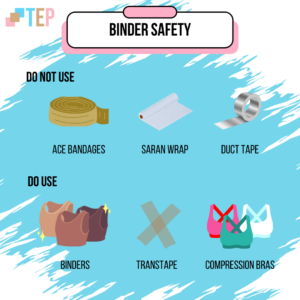

Binding is also only safe in moderation. The constricting nature of binders puts a lot of stress on one’s ribcage and spine. If usage is prolonged it can cause damage to one’s body, so it is important to take breaks and let your body rest between binding sessions. It is recommended that one not wear a binder for more than 8hrs on a day, and that one not sleep or do intensive exercise in them. If one ever feels faint or lightheaded whilst wearing a binder, it is time to take that binder off. It is also important to keep one’s binder clean to prevent any skin infection from forming. For these reasons, it is also unwise to wear a binder that is too small (binder sizes are typically the same or are based upon one’s bra size, you can check out GC2B’s sizing guide for a better understanding)
Safe Binding Alternatives
- Wearing Darker Clothes – Dark clothing has a slimming effect making things appear smaller than they are and they eliminate any contrasts that would be present in folds on light clothes that would draw attention to one’s chest.
- Layering Clothes – The volume of clothing creates an evening effect across your torso, hiding one’s chest.
- Wearing Compression/High-Impact Sports Bras – These bra styles give a flatter and more even appearance than others as they are built to keep your breasts from moving around during intense exercise.
- Transtape – This is a specialized adhesive that can be used to tape down various body parts.
Bras and Breast Forms
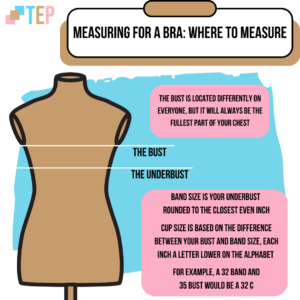
Measuring for a Bra
You will need a measuring tape that is in inches. For best results, measure against the skin instead of over clothes. Do not pull the measuring tape too tight or leave it loose – it should be snug, but breathable. The best starting point when measuring is the sides of your torso, underneath the armpit.
- Measuring for band size – For this, you want to measure your underbust. Your underbust is located just above the ribs, underneath the chest. Circle the measuring tape once around and place your finger where the tape meets the start point. That is your measurement. If it is even, perfect! If it is an odd number, round up to the closest even. If it’s in between numbers (has a fraction), round up or down to the closest even. The even number you get will be your band size!
- Measuring for cup size – For this, you want to measure your bust. Your bust is the fullest part of your chest (for AMAB folks, this will typically lie around the center of your nipples). To make sure you include all your breast tissue, measure yourself while bent over (having your chest parallel to the ground). Circle the measuring tape around and place your finger where the tape meets your start point. Take that number and your band size and subtract the two to get the difference between them. Every inch difference is a cup size up. 1 inch = A cup, 2 inch = B cup, 3 inch = C cup – so on and so forth.
These measurements put together are the base for your size. You can go up or down on this size (these are known as sister sizes) to find fits that may be more flattering, and you should keep in mind that different styles of bras can also affect the fit and comfortability of a size. You may find yourself using your base size for a bralette, but a sister size for a strapless.
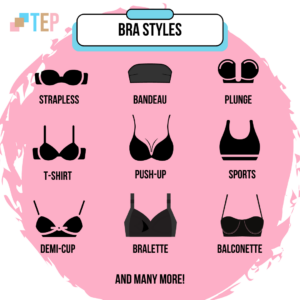
If for some reason, these sizes do not work for you in any style, some Trans Women have reported having better luck with their tux size as the band instead of the typical bra measurement.
You may also want to leave some allowance in the cup size for the usage of Breast Forms.
Breast Forms are breast-shaped prosthetics worn inside one’s bra or against one’s skin to give a curvier appearance to one’s chest. They’ve been used by MTF and MTX individuals to combat gender dysphoria, but they’ve also been used by other gender identities including cis women to fill out their bra for reasons such as having lost tissue, or to even out existing tissue that is asymmetric, or just to have a curvier aesthetic.
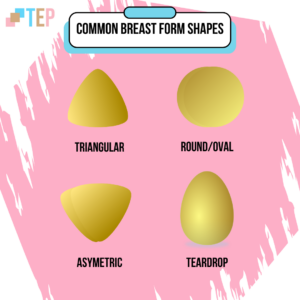
Breast forms come in many shapes, styles, and sizes. Some shapes will look better in certain bra styles, though generally styles such as demi-cups and push-up bras are to be avoided with the usage of breast forms, as their open/display type designs would risk your breast forms slipping out and revealing their falsity.
The care for your breast forms will differ depending on the material used, but most can be cleaned with a mild soap. They should be cleaned regularly to prevent skin rash and infection.
Alternatives to Breast Forms:
- Stuffing your bra- You can fold up socks, tissues, or other cloth materials and stack them in the bottom of your cup to push what breast tissue you have upwards and out.
- Layering bras- You can wear another bra under your bra to give some volume to your chest.
Packers & Packing
A packer is a prosthetic one wears to simulate a penis. There are three different functions a packer can have: to pack in your pants to simulate a bulge (Pack packers), to stand-to-pee (STPs), or for usage in more amorous activities such as sex (Play packers). A single packer can have all three functions, but the majority only have one or two of these functions, and the more functions it has, generally, the more expensive it gets.
Packers come in various sizes, but a good guideline for a realistic bulge is 3.5 inches, as that is the average length for a flaccid penis. For something more erect, the average is around 5.3 inches.
A packer can be rather difficult to keep in place, but there are options to make it more secure.
- Packing Underwear – underwear made specifically for FTMs with a pouch dedicated to holding your packer
- Men’s Underwear with the following labels: pocket underwear, separate pouch, or scrotum separation – these types of underwear are almost identical in design to packing underwear and have the pouch necessary to keep your packer secure
- Packing Harnesses – harnesses that slip around the prosthetic and are strapped around your waist and/or bottom, holding your packer in place against your body
- A Jockstrap (without the hard cup) – this undergarment is designed to hold a penis in place; it has plenty of room for your prosthetic and is also tight enough in other areas to keep the packer from slipping.
- Homemade Packing Garments – when you don’t have much money, making your own is often the answer. Many people will safety pin a sock to the front of their underwear that will then hold your packer.
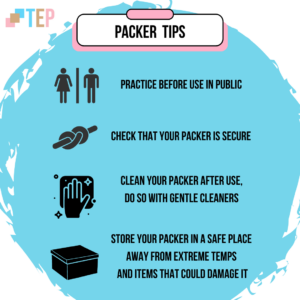
It may be a good idea, especially with STP’s, to practice using your packer in a safe space.
After use, you should make sure to clean your packer. This goes double for STP or Play packers. Not cleaning can result in skin rashes, yeast infections, UTIs, bacterial vaginosis, and/or STDs. You should also be careful in your cleaning. Unfortunately, packers are rather fragile. They can dent or bend quite easily and can be melted with enough heat, so it’s important to be gentle and to store them properly. A box or drawer kept away from heat sources will do wonders for a packer’s shelf life.
Some Alternatives to Packers
- Foam Inserts – an alternative for pack packers, insert into your underwear to give an illusion of a bulge
- Bundled Socks – an alternative for pack packers; it’ll feel weird, but putting a bundled-up sock in your underwear can give the appearance of a bulge
- Urine/Pee Funnels – an alternative for STPs, pee funnels are a tool for AFAB and/or disabled people to use outdoors or to avoid unsanitary situations
- Dildos – an alternative for pack or play packers, can be worn with the use of a harness to simulate a bulge and can be used to give yourself or your partner pleasure
Tucking
Tucking is the act of hiding or “tucking away” one’s penis and scrotum in order to give a flatter appearance to one’s nether regions. Tucking can be performed by MTF or MTX people to reduce gender dysphoria, but can also be performed by any gender in order to fit aesthetics for instances such as cosplay, theatrical performance, costume, and drag. One, however, may want to practice a few times in a safe space before trying to tuck for public appearances.
When repeatedly tucking one may experience symptoms such as chafing, urinary trauma, infections, and testicular complaints. However, they should never feel pain during the process itself. If one feels pain, they should stop the tucking process immediately. Do not force the genitals, take a break and try again at another time. Do not tuck for more than 8 hrs a day, and be sure to let your body rest between tucks.
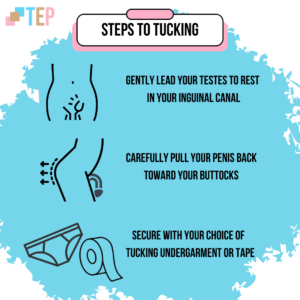
Steps to Tucking
- Before Starting the process, you should consider which method is best for you:
- Tape- By tape, we are referring to medical grade or Transtape tapes. Other tapes, such as duct tape, are not meant to adhere to you and will either not stick or damage your skin. Before using tape, it is important to shave your genitals. Any hair present could make it harder for the tape to adhere and will most certainly make the removal process of that tape an unpleasant experience. In general, a tape tuck will be more prone to discomfort and more difficult to remove/reapply, but it will also be the most secure method.
- Underwear- You will want the undergarment of choice nearby so you won’t have to move around too much to secure the tuck (and if it doesn’t affect your balance or flexibility to do so, you may even want to have it already pulled on to about knee height for a quicker secure), but otherwise there is no preparation specific to this method. Some people will layer with multiple garments, securing with a smaller-sized panty and pulling one’s average size over it, or make use of pantyhose or shapewear, but layers are not a requirement. The drag community has specifically noted bikini bottoms as a good undergarment alternative to tape. Underwear in general is going to be much easier to get in and out of for visits to the restroom and will be less abrasive, but they will also not be as secure.
- Gaffs- Gaffs are undergarments that are specifically designed for tucking away one’s genitals. Its securing and removal process is the same as any undergarment, and it is closer to the security that tape provides, but it can also produce similar discomfort to the tape method.
- Lift the testes up to rest in the inguinal canals (the inguinal canals are two sockets located in the pelvic floor, close to where your legs meet your groin). The best way to do this is to lie on your back and use 2 to 3 fingers to gently shift the testes upward until they are settled in the inguinal canals.
- A cold shower or bath beforehand may help with this process, as the cold will cause the testes to naturally ascend and rest closer to the inguinal canals.
- If you are using tape, you can go ahead and use it to secure the testes in place, otherwise do your best to hold them steady as you move onto the next step.
- Pull the penis and scrotum down and back, between the legs and toward the buttocks. While they are held in place, please double-check for any signs of discoloration, numbness, or throbbing. If any of these signs are present, the penis and scrotum are being pulled too tight and too far back, release them back to their natural positions and let them recover before trying again.
- To reduce health risks, the penis head should be wrapped in some kind of cloth material. This will help to prevent any anal bacteria from entering the urethra and causing infections. Some individuals also recommend applying antifungal powder to the area.
- Secure it all either with tape (tape all genitalia down into place), underwear, or gaff (slide them over the genitalia).
- Go about your day!
Untucking
- Go in reverse order of how you tucked; release the penis and scrotum first, then the testes.
- For Tape- Soaking the tape with warm water will help immensely with the removal. The water will wash/melt away the adhesive, making it easier to peel off (you can also use a medical adhesive remover). Once you have peeled the tape off you can just gently guide your genitals back to their natural resting positions.
- Underwear or Gaff- Remove the garment and gently lead your genitals back to their natural resting positions.
